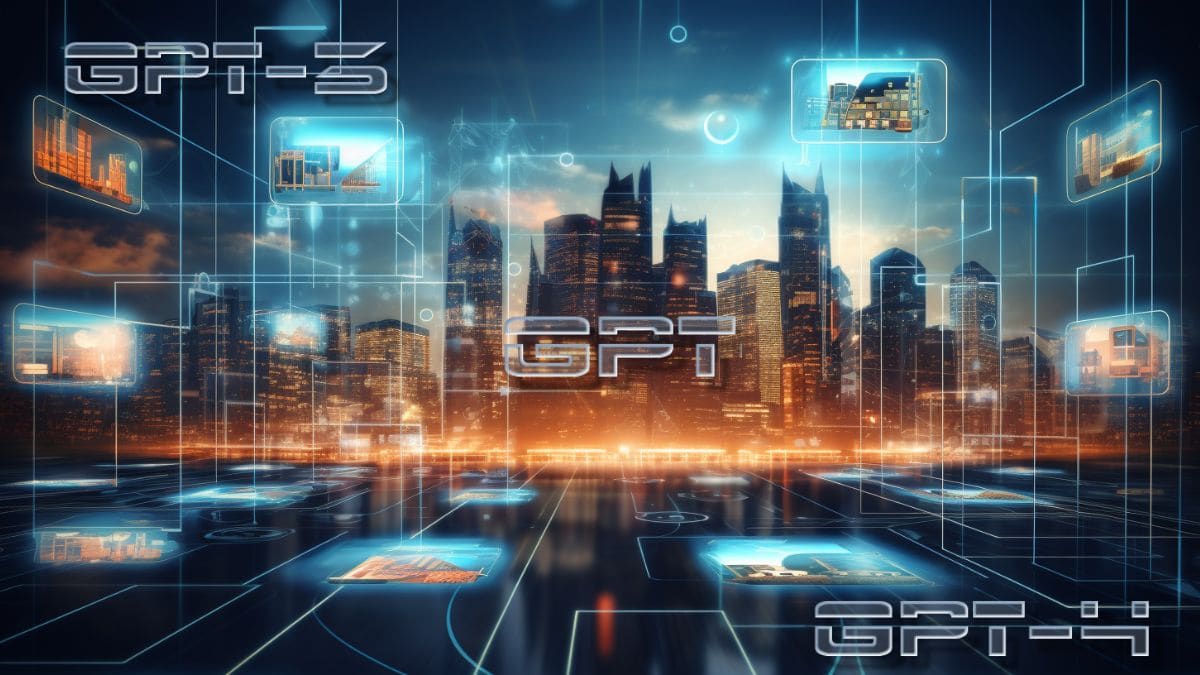Imagine a world where AI technology can generate human-like text, assist in medical diagnoses, and even create captivating works of art. This world is no longer a distant dream, but a reality made possible by the groundbreaking advancements in GPT-3 and GPT-4 AI technology. In this comprehensive exploration, we will dive into the fascinating world of generative pre-trained transformers, uncovering their potential, applications, and the science behind them. Fasten your seatbelts as we embark on a thrilling journey through the realm of AI language models that are revolutionizing the way we live and work!
Short Summary
- GPT-3 and GPT-4 are revolutionary AI language models capable of generating human-like text across a variety of tasks.
- Advantages include cost savings, improved customer service experience, automated content creation processes and data analysis capabilities.
- Challenges must be acknowledged to ensure successful integration into real world applications with ethical considerations in mind for the advancement of these technologies.
Understanding GPT-3: A Revolutionary Language Model
GPT-3, developed by OpenAI, is a groundbreaking language prediction model, boasting an impressive neural network with over 175 billion machine learning parameters. This revolutionary language model is capable of processing text input to carry out a range of natural language tasks, such as generating human-like text, composing articles, poetry, stories, news reports, dialogue, and even programming code. The sheer magnitude of GPT-3's neural network allows it to generate text that appears to be written by a human, surpassing any prior model.
The foundation of GPT-3 lies in its neural network machine learning model, which takes input text and generates the most probable result. Trained on a variety of data sets, including Common Crawl, WebText2, and Wikipedia, GPT-3 employs a text predictor that generates high-quality output based on models trained on its extensive, training data used.
Remarkable Applications of GPT-3
From generating captivating content for websites and social media to aiding with market research and analysis of user and customer feedback, GPT-3 has a broad range of applications. Its ability to automate tedious tasks and extract valuable insights from data makes it a versatile tool in various industries.
In the following subsections, we will delve deeper into GPT-3's applications in chatbots and customer support, marketing teams creative content generation, and medical and technical fields.
Chatbots and Customer Support
One of the most notable applications of GPT-3 is in the creation of chatbots that understand natural language and respond to customer queries. In November 2022, OpenAI launched ChatGPT, a program designed to minimize the likelihood of potentially dangerous or misleading replies.
ChatGPT has been optimized for human dialogue, allowing it to inquire further, acknowledge errors, and dispute incorrect assumptions. Although the GPT-4 based version of ChatGPT is an improvement on the previous GPT-3.5 based version, it still retains some of the same issues.
Automated customer support powered models trained by GPT-3 can significantly reduce costs by diminishing the need for human customer service agents. Additionally, GPT-3 can be employed to assess customer feedback and furnish insights into customer sentiment, making it a valuable asset for businesses seeking to enhance their customer service experience.
Creative Content Generation
GPT-3's ability to generate high-quality creative content is truly remarkable. Developers have harnessed its potential to produce code snippets, regular expressions, plots and charts from text descriptions, and even Excel functions. This automation of content creation not only saves time, but also allows for more efficient use of resources.
GPT-3 is an AI system with amazing creative capabilities, and one example of this in practice is Dall-E. It was built using a 12 billion-parameter version of GPT-3 to generate images. Trained on a dataset of text word-image pairs, Dall-E is capable of creating unique images based on textual word input, showcasing the immense potential of GPT-3 in creative content generation.
Medical and Technical Fields
The potential of GPT-3 extends beyond language-related tasks, reaching into the realms of medical and technical fields. In 2022, a study was conducted to evaluate the potential of GPT-3 in aiding the diagnosis of neurodegenerative diseases like dementia. It focused on detecting common symptoms like language impairment in patient speech. This groundbreaking application showcases the immense possibilities of using GPT-3 in healthcare.
In addition to medical applications, GPT-3 can be employed in technical fields, such as engineering and science, to analyze large datasets and generate reports. While its use in such large scale models these fields raises potential bias and privacy concerns, the benefits of leveraging GPT-3 for data analysis and report generation are undeniable.
The Science Behind GPT-3
GPT-3's prowess system is based on a neural network machine learning model trained on a comprehensive corpus of internet text and examples, a large language model which allows it to detect patterns and generate the most probable result. By employing a text predictor based on examples from its training data, GPT-3 can produce high-quality output text that closely mimics human writing.
This extensive training process, known as generative pre-training, is the cornerstone of GPT-3's impressive capabilities. By learning from a wide variety of data sets, such as Common Crawl, WebText2, and Wikipedia, GPT-3 gains a broad understanding of language and context, enabling it to generate human-like text across a large language models and wide range of tasks.
Advantages of Implementing GPT-3
Implementing GPT-3 offers numerous advantages for businesses and individuals alike. Its ability to generate high-quality content quickly and accurately can translate into significant cost savings, particularly in content creation and customer service.
GPT-3's lightweight design allows it to operate on common laptops and mobile devices, making it an accessible tool for users seeking to improve efficiency in their work processes. Furthermore, its capacity for developers to generate chatbots that provide automated responses to customer inquiries can lead to improved customer service and additional cost savings.
Recognizing GPT-3's Limitations and Challenges

While GPT-3's potential is undoubtedly impressive, it is important to recognize its limitations and challenges. for example, GPT-3 in code has been known to generate biased text and struggle with tasks that require more complex reasoning, and it lacks contextual understanding of user will.
As we utilize GPT-3 in various applications, ethical and user safety considerations must be taken into account. The potential misuse of this technology for illegal activities and the possibility of it being used to propagate misinformation are two example of genuine concerns that need to be addressed when implementing GPT-3 in real-world user scenarios.
GPT-3's Journey: From Research to Real-World Applications
GPT 3.5-3's journey began in 2018 with the introduction of the first GPT-1 model by OpenAI. Fast forward to 2020, and the release of GPT 3.5.-3 marked a significant milestone as the largest neural network ever built, boasting 175 billion parameters.
To monitor usage and avoid potential issues, OpenAI released access to GPT 3.5-3 gradually, with users required to submit an application during its beta period. The beta period ended in October 2020, and OpenAI introduced a tiered credit-based pricing system, ranging from free access to higher-cost tiers for larger-scale access.
Microsoft now holds exclusive access to GPT-3's underlying model code, and GPT-3's impressive capabilities have been harnessed by various organizations, showcasing its potential to transform numerous industries. From creative content production internet data, to customer service, GPT-3 has made remarkable strides in revolutionizing the way we interact with technology.
Gazing into the Future: Beyond GPT-3
As we look beyond GPT-3, GPT-4 emerges as the latest advancement in scaling up deep learning research, surpassing ChatGPT in its advanced reasoning capabilities. With more data and computation, GPT-4 promises to create even more sophisticated language models that can further revolutionize the way we live and work.
GPT-4's potential applications extend beyond language-related tasks, offering use in industries such as content creation, customer service, and data analysis. By the language task of generating human-like responses and the language task of translating into other languages, GPT-4 has the potential to improve communication and enhance our understanding of the world around us.
What is GPT-4?

GPT-4, the most recent achievement in OpenAI's endeavor to increase deep learning, is a safer and more aligned AI language model than its predecessors. With increased training data and computation, GPT-4 is capable of creating advanced language models that can tackle a wide range of tasks, including creative and technical writing, song creation, screenplay scripting, and even mimicking a user's writing style.
GPT-4's enhanced capabilities and alignment with human values make it a promising tool for the future of AI language models.
GPT-3 and GPT-4: What's the difference?
GPT-3 and GPT-4, both AI language models developed by OpenAI, differ in terms of their capabilities and data. the earlier GPT models i-4 is much more nuanced instructions powerful than the earlier GPT models i-3, exhibiting increased accuracy and speed. While the size and performance of GPT-4's model remains undisclosed, it is clear that GPT-4 represents a significant step forward in the development and performance of AI language models.
GPT-4's improvements stem from its more expansive and robust training, as well as its ability to process and respond to visual inputs. This multimodal capacity allows GPT-4 to interact with both text and images, setting it apart from several limitations its predecessors and opening up new possibilities for AI language models.
What does GPT-4 stand for?
GPT-4 is an acronym for Generative Pre-trained Transformer 4, which is the first version of a large multimodal language model developed by OpenAI. As the fourth generation in the GPT series large language models, GPT-4 builds upon the foundation laid by its predecessors, offering enhanced capabilities in reinforcement learning and alignment previous models with human values, making it a significant player in the AI language model landscape.
What's new in GPT-4?
GPT-4 brings a host of new features and capabilities to the table, with safety implications such as its ability to analyze context and show text description describe images, and its improved alignment with human values. By incorporating human feedback and enhancing GPT-4's behavior, the Safety & alignment section of GPT-4 aims to minimize the likelihood of potentially dangerous or misleading replies.
However, GPT-4 is not without its limitations same problems. It has been observed to exhibit social biases, hallucinations, and vulnerability to adversarial prompts. As we look to the future of GPT-4, it is important to address these challenges and continue refining the model's ability to ensure its safety and effectiveness.
GPT-4 vs. GPT-3
GPT-4, released in 2021, has been adopted by several organizations, such as Duolingo, Be My Eyes, Stripe, Morgan Stanley, Khan Academy, and Iceland. Compared to GPT-3, GPT-4 offers enhanced capabilities, such as generating text with a more natural flow, providing more accurate solutions to problems, and processing images in addition to text.
As GPT-4 continues to be refined and developed, it is poised to further revolutionize the way we interact with AI language models.
When was GPT-4 released?
Although GPT-4 has not yet been released, it is anticipated to be launched on March 14, 2023. Upon its release, GPT-4 is expected to bring a new wave of innovation and advancement in the field of AI language models, further expanding the possibilities for AI-powered technologies in various industries.
Gazing into the Future: Beyond GPT-4
It is crucial to tackle the problems associated with GPT-4's advancement, including social biases, hallucinations, and adversarial prompts. Such challenges must be addressed in order to move forward with the research phase of its development. By working to increase transparency and broaden input avenues, GPT-4 aims to become an even more powerful and versatile tool in the research preview the future.
With its potential to revolutionize industries and improve communication, GPT-4 represents a significant step forward in the development of AI language models. As we gaze into the future beyond GPT-4, it is exciting to imagine the limitless possibilities that await us in the realm of artificial intelligence.
Summary
In this comprehensive exploration, we have journeyed through the captivating world of GPT-3 and GPT-4 AI technology, uncovering their potential, applications, and the science behind them.
From revolutionizing customer service and content creation to transforming medical and technical fields, these groundbreaking language models hold immense promise for the future. As we continue to refine and develop these technologies, we stand on the precipice of a new era in artificial intelligence, unlocking possibilities beyond our wildest dreams.






